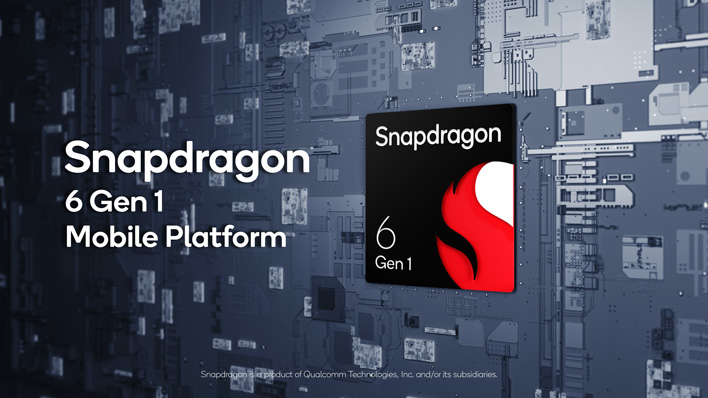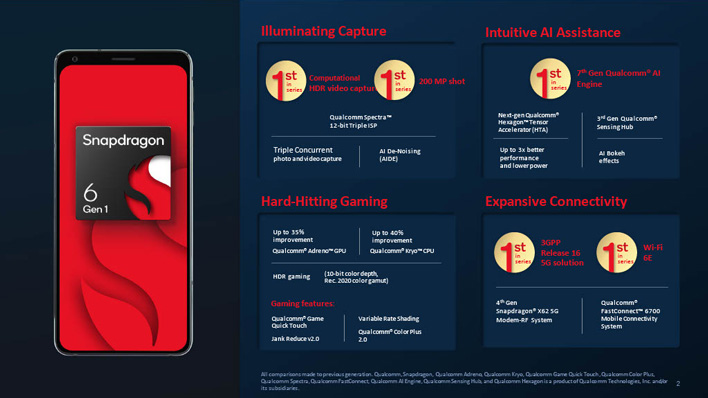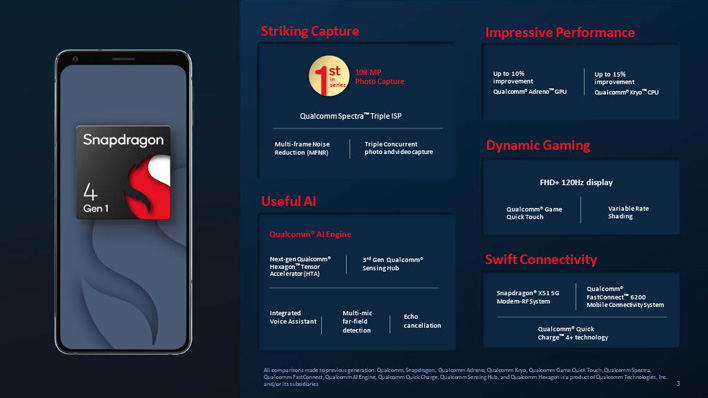Qualcomm Unveils Snapdragon 6 And 4 Gen 1 Platforms To Supercharge Midrange Devices
The Qualcomm Snapdragon 6 Gen 1 is focused on bringing improved image capture capabilities and smoother gaming to midrange devices. The SoC integrates three image signal processors—the Spectra Triple ISP—which allows devices to capture from three cameras at once. This has applications for computational photography including support for staggered HDR image sensors for the first time in the 6-series. The system also supports high resolution sensors up to 108 MP and incorporates AI De-Noising (AIDE) to improve the appearance of low-light images.
The Snapdragon 6 Gen 1 (SM6450) is built on a 4nm process which offers significantly improved computational performance compared to the Snapdragon 695 5G. Qualcomm specifies an improvement of up to 35% quicker graphics rendering by the Adreno GPU and up to 40% faster processing by the Kryo CPU over its predecessor. It claims this is suitable to deliver 60 frames per second or more in HDR gaming titles with high-quality visuals and real-time responses. We do not typically think of midrange processors for high-end mobile gaming, but Qualcomm has made a concerted effort to improve the experience since the introduction of the Snapdragon 730G in 2019.
Qualcomm further enhances gaming with a few other capabilities. The Snapdragon 6 Gen 1 supports Variable Rate Shading. This is a technique that allows the GPU to apply different rendering performance to different areas of the frame. Low focus areas do not need as much attention and can get away with less detail to optimize limited compute resources. The SoC also features Qualcomm’s upgraded Jank Reducer v2.0 and Color Plus 2.0 for a more fluid and vibrant gaming experience. It supports displays up to FHD+ with a 120 Hz refresh rate.
The SoC includes Qualcomm’s 7th generation AI Engine with Hexagon Tensor Accelerator to improve AI performance offloaded from the CPU. Qualcomm indicates this is capable of 3x improved AI performance compared to the Snapdragon 695 5G. The system supports the always-on Qualcomm Sensing Hub for tasks like AI-based activity tracking to make suggestions based on contextual clues. It further incorporates the Snapdragon X62 5G model with FastConnect 6700 Wi-Fi 6E and Bluetooth 5.2 connectivity to keep users in touch.
On the mass-volume front, the Snapdragon 4 Gen 1 (SM4375) is geared towards improving everyday experiences using a 6nm process. It supports Qualcomm’s Quick Charge 4+ Technology which can fuel up to half of a device’s battery capacity in 15 minutes. The Snapdragon 4 Gen 1 promises up to 15% Kryo CPU performance and up to 10% Adreno GPU performance over the Snapdragon 480 5G platform. Qualcomm claims it can handle some AAA titles at high framerates with minimal frame drops.
The Snapdragon 4 Gen 1 borrows some of the new 6-series photography capabilities. It is similarly capable of capturing from up to three cameras simultaneously at 13 MP and 30 FPS without slowing down. It alternatively supports a single 108 MP image capture and uses Multi-Frame Noise Reduction (MFNR) to improve low light images.
The new 4-series processor also incorporates the Qualcomm AI Engine with Hexagon Vector eXtensions (HVX) to offload CPU tasks. It uses the always-on capabilities to accelerate voice assistant functions, perform voice detection, and offer echo cancellation with background noise suppression. The Snapdragon 4 Gen 1 is 5G enabled with the X51 modem and supports Wi-Fi 5 2x2 with Bluetooth 5.2 connectivity.
The Snapdragon 4 Gen 1 is expected to be available in devices starting this year in Q3. The Snapdragon 6 Gen 1 will begin to see commercial availability in Q1 of 2023.




